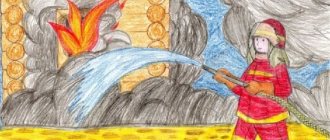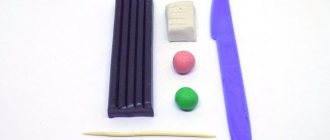Lesson notes for the senior group “Fire is a friend, fire is an enemy” Social world.
Lesson notes for the senior group “Fire is a friend, fire is an enemy” Social world.
Goals:
1. Teach children to talk about the benefits fire brings to man and how man learned to control fire.
2. To consolidate children’s knowledge of what can result from careless handling of fire. Know and follow the rules of behavior in case of fire.
3. Instill in children respect for the work of firefighters.
Methodical techniques:
Game;
Visual;
Verbal.
Equipment:
danger sign, fire symbol, fairy tale “Fire is a friend, fire is an enemy”, pictures, presentation.
Preliminary work: excursion to the fire station, didactic game “Who Needs What,” reading L. Tolstoy’s story “Fire Dogs.”
Vocabulary work:
firefighters, flames, smoke, burn.
Progress of the lesson
Teacher. Children, now I will show you one of the signs, and you must say what it is called. That's right, this is a danger sign. Now let's play. I will stand here, and you will name some danger that a person encounters in life, and approach me one by one.
Children take turns listing: fire, earthquake, accident, flood, flood, poisonous mushrooms and berries, dangerous animals and people, etc.
Teacher. That's right, a person can face these dangers in life. And now I’ll tell you a riddle about one of these dangers, and you try to guess it:
He's a friend of the guys
But when they play tricks on him,
He becomes an enemy
And it burns everything around.
(Fire.)
That's right, this is fire (shows the fire symbol).
And now I’ll tell you a fairy tale about fire: “Fire is a friend, fire is an enemy.”
Once upon a time there was Fire. He was very cheerful and hot. Fire walked wherever it wanted - through forests, houses, trees. Fire spared no one on its way and was the worst enemy of all living things.
Why do you think?
Children. He burned everything.
Teacher. And then one day he met a man on his way and said: “Come on, Fire, let’s measure our strength.” Fire replies: “How can you, Man, compare your strength with me?” But the man insisted on his own, Fire agreed. So their battle began. The man lured Fire to the river and jumped into the water. The Man grabbed the flames with his wet hand and wanted to extinguish them. Fire prayed: “Don’t put me out, Man, I will serve you faithfully.” The Man took pity on him and forced him to serve himself. This is how Fire began to serve Man and became his friend.
Tell me, why does a person need fire?
Children. In order to cook food, keep warm, can provide lighting, light a candle, etc.
Teacher. Without fire, people would never be able to travel on earth, travel through the fields. Fire also works in a car engine - gasoline burns and sets the car in motion. Fire also blazes in furnaces in factories; it melts metal; in other furnaces, fire cooks glass, from which beautiful glass products are blown. A space rocket flies up, leaves a bright tail of flame - this is the rocket fuel burning.
But when fire falls into the hands of small children, it shows its character, strives to run away from them and walk around the house, through the forest, through the field. From a good servant, fire can turn into a fire-breathing dragon. Then something bad might happen.
Tell me, what could cause a fire?
Children. From a match, an unextinguished cigarette butt, an unturned off gas stove and electrical appliances.
Teacher. What can catch fire at home, in the forest?
Besides fire, what else is dangerous about fire?
Children. Smoke - you can choke on it.
Teacher. And now I suggest you play. The game is called "Make no mistake." I will name objects, and if this object is burning, you will raise your hands up, depicting tongues of flame, and if it is not burning, you need to lower your hands.
Words: paper, nail, curtains, tablespoon, notebook, clothes, table, furniture, dry grass, leaves, gasoline, paint.
Teacher. Well done, sit down. Now let’s play the game “Cross – Question”. There is a picture hidden here, if we answer all the questions, we will tell you what is shown there.
Questions for children:
- What are the people called who put out fires and save people and houses from fire? (Firefighters.)
- Why do people need the work of firefighters? (They put out fires in houses, forests, save people, their things, houses.)
- What is their job? (Difficult, difficult, needed by people.)
- What should firefighters be like? (Strong, brave, seasoned, dexterous, decisive.)
- Why do they have to be strong and brave? (They take people out of the fire, work in the fire and smoke.)
- Why do firefighters wear a gas mask? (So that you can breathe when there is smoke.)
- What number do they call firefighters? (“01.”)
- What should you say when calling the fire department? (What happened and exact home address.)
Teacher. Well done, they answered all the questions, and we got a picture - this is a fire truck. You can quickly rush to a fire with it.
Now stand up, we'll play with the ball. The game is called “Catch, throw, answer immediately.”
Why does a fire truck need a siren? (So that everyone can hear and give way.)
Why is the fire truck red? (To make it visible on the roads: red is the color of fire.)
Why does a car need a sliding ladder? (To climb to high floors.)
What are the names of the long hoses used to extinguish fires? (Sleeves.)
Where do firefighters get water if they run out of water in their car? (In wells, from the river.)
Teacher. What do you need to know to prevent trouble from happening? It is imperative to know the rules on how to behave during a fire. We will consolidate them in the game “Allowed - Prohibited”.
Take your traffic lights in your hands and show a red circle if this cannot be done, and a green circle if this can be done:
- In case of fire, call the fire department by calling “01”;
- Throw burning matches;
- Scream and call adults for help;
- Stay in the room where the fire started;
- Open windows and doors during a fire;
- Cover your mouth, nose and head with a wet towel;
- Hide in the corner under the closet under the bed;
- Leave switched on electrical appliances unattended;
- Move crawling or crouching towards the exit;
- Douse walls and floors with water during a fire;
- Use the elevator;
- Do not be afraid to obey the firefighters in everything;
- Extinguish burning electrical appliances with water;
- Ask neighbors for help;
- Try to put out the fire if possible;
- Turn on gas, electrical appliances and lights.
Teacher. Well done, you mentioned all the rules.
The fire leaves behind a terrible trail: instead of a forest, a house - ashes, ash, burnt brands. How does a person suffer from a fire?
Children. He gets burns and suffocates from smoke.
Teacher. It is very important to provide first aid to a person. See what to do if you have a minor burn.
Teacher. You must remember that a fire is not an accident, but the result of incorrect behavior. Today you learned that fire can be both a friend and an enemy for us, but still there is more benefit from it than harm. Fire makes our life warmer and more comfortable. I want you to be very careful with fire, attentive, remember the danger, always follow the rules, and trouble will pass you by.
Summary of a lesson on introducing children to social reality in the senior group
Summary of a lesson on introducing children to social reality in the senior group “Objects of the man-made world”
Author: Tatyana Gennadievna Borodina, teacher of the senior group of State Budget Educational Institution Secondary School No. 289 (kindergarten No. 1867) in Moscow.
I offer you a summary of a lesson on speech development for children of senior preschool age. This material will be useful to teachers of older groups of kindergarten. The lesson is aimed at cultivating interest and respect for objects of the man-made world.
Topic: Objects of the man-made world.
Program content. Educational objectives. • Expand children's knowledge about objects of the man-made world. • Clarify children's knowledge about the meaning of objects in the man-made world. • Talk about helping objects for each profession of people. • Bring children to the conclusion that objects, just like people, have their own past, present and future. • Develop children's coherent speech. • Continue teaching children to answer questions and find the correct answer. Educational tasks. • Foster a caring attitude towards objects created by human hands. • Cultivate interest in studying the history of objects. Preliminary work. • Reading the story by K.D.
Ushinsky “How a shirt grew in a field.” • Examination of illustrations depicting various objects. • Conversation about the objects around us. • Getting to know a person's professions. • Parents telling their children about their childhood toys. Progress of the lesson:
- Guys, let's look around us! What do we see? - That's right, objects. All these objects were created by man. - Guys, what do you think we need the items for? — We need objects in order to play, study, work and relax. With the help of objects we eat and take care of our body. — Guys, what do you think we need for the game? - That's right, of course, these are toys!
Toys and many other items, such as children's books, clothes and shoes, were specially created by adults for children. — What items will we need for school?
- That's right, a backpack, a pencil case, a pen, a pencil, scissors, a ruler, an eraser, a notebook and a primer. — Guys, what items help your moms and dads in their work? Let's remember together. I will help you. This is a computer, telephone, shovel, watering can, books, scales, car and others. - Guys, do you know that people of different professions have their own helper objects.
For example, a salesperson in a store is helped by scales - he weighs the goods on them; he also needs a cash register - on it he punches out a receipt and puts money in it. A gardener needs a sprayer, a watering can and scissors for pruning plants. The janitor is helped in his work by a shovel, a broom and a bucket. And when working with children, a teacher needs a lot of children's books and games, a board, chairs and desks. - You see, each person has his own objects that help him in his difficult work. Guys, but if there are objects for work, then there are objects for relaxation. What do you think these objects are? - Of course, this is a bed, an armchair, a TV, a telephone, a tape recorder, a pillow, magazines, sunglasses, an inflatable ball and a circle. Many items can be used for both work and leisure.
For example, a person can communicate by phone while working and when resting. — Guys, what items help you and I eat culturally? What do we drink from, eat, what do we eat? - That's right, this is a cup, plate, spoon, fork, knife and napkins. — Guys, what items help you and I take care of our bodies? - That's right, this is soap, a washcloth, shampoo, a toothbrush and toothpaste, creams, a comb. - Guys, now let's play a very interesting game with you. I will name any item for you, and you will tell me what it is for. For example, a watering can. And you say to water the plants. Is everyone clear? Be careful! - Sasha, what is the chair for? -Right enough to sit on. - Katya, what is the pen for? - It's right to write to her. (I name the following words: doll, ball, elastic band, hairpin, spatula, table, pencil, notebook, umbrella, vase, wardrobe, etc.). - Well done, you know everything! — Guys, objects were invented by ancient people. Over time, people changed and improved them. People today continue to change objects to make them more convenient and better. Each object has its own past, present and future. So your toy that you play with at home has its own manufacturing history. Listen to her. Before she came to your home, she wandered around the world for a very long time. First it had to be made. For example, a soft toy was sewn at a toy factory, and then taken to a store where your parents bought it for you. But the cars our boys play with are made of metal and plastic. A table and a chair, our desks, can tell us a very long and interesting story.
Imagine, at first they grew in the forest in the form of a tree, then the tree was cut down and boards were made from the trunk. They assembled the table and chair, sawed it, polished it, covered it with paint and varnish and took it to the store for sale. Now here they are in our group. Furniture has gone through a difficult process of production, and it needs to be taken care of. - Guys, all objects created by human hands must be protected so that they serve us longer! — The lesson is over. Well done everyone!
We recommend watching:
Summary of educational activities in the senior group “Journey to a Fairy Tale” Summary of a mathematics lesson for children of the senior orthopedic group Summary of educational and gaming activities in the senior group in the section of the “Childhood” program Synopsis of educational activities for the perception of music in the senior group of kindergarten
Similar articles:
Lesson in the senior group of kindergarten on the topic of February 23
Lesson notes for children of senior preschool age. Topic: Invisible air
Summary of organized educational activities for children of the senior group
Notes for mathematics classes in the senior group
Lesson summary on the topic “Reserve” in the senior group
Goal: development of the emotional sphere of preschoolers.
Tasks:
1. Continue to teach to understand the emotions of others by facial expressions, gestures, and body movements.
2. Develop ideas about the individual characteristics of people, that each person is unique.
3. Continue to cultivate group cohesion, attention to yourself and your partner, the ability to overcome isolation and passivity; desire to participate in joint games.
Material: flying carpet, audio recording of sad and cheerful music: “Crybaby” by D.B. Kabalevsky, “Chunga-Chang” by music by Shainsky, lyrics by Yu. Entin, pencils, albums.
Progress of OOD
Educator: Good morning and smile at everyone,
Bow to your friends on the right and left.
We will be friends, we will always help everyone -
Do you agree? Answer me: “Yes!”
Educator: Today I propose to go on an unusual journey. But before you go on a journey, you need to know who you will be traveling with for the long haul. (The children are in a circle, and the leader recognizes the child by touch. We have recognized everyone, and now we are going on a journey.
Educator: And we will travel on a carpet airplane. You need to stand on this multi-colored carpet, close your eyes and fly.
We arrived at the North Pole and it is very cold here. How can we show that we are cold, sad and lonely?
Expressive movements: knees are closed so that one knee covers the other, hands near the mouth - warmed by breathing.
Educator: We visited the North Pole. Let's continue our journey. Now we are on a magical island where only crybabies live. The people of this island are upset all the time and often cry. Depict the inhabitants of this island. (The play “Crybaby” by D.B. Kabalevsky is played.)
Educator: Which is very sad for the inhabitants of this island. Let's try to cheer up the crybabies. Now divide into pairs. One of you will portray a sad person, the other should cheer him up, make him smile, laugh. You can't touch it with your hands. (Children complete the task; when the task is completed, they change places.)
Educator: Now we get up on our magic carpet and fly further. And they ended up on a wonderful island, where everyone is always joyful and carefree. Let's have fun together with fun music. (The music of “Chunga-Chang” sounds, music by V. Shainsky, lyrics by Yu. Entin.)
Educator: And now we flew on and we ended up on Molchunov Island. On this island no one talks, everyone is silent, communicating with each other using the movements of their hands, bodies, and gaze. Divide into two groups. One should remember some famous fairy tale, assign roles and try to act it out without words. The second group will have to guess what kind of fairy tale this is and who is portraying whom. (Children show a fairy tale.)
Educator: Our journey ends. And our magic carpet flew to the kindergarten. Did you enjoy your trip?
Educator: And now you need to draw what you remember most about your trip. (Children go to the tables and draw.)
Educator: Guys, did you like our trip? Well done, you were friendly, active today and completed all the tasks. I wish you a good mood and that you say good and kind words to each other.





